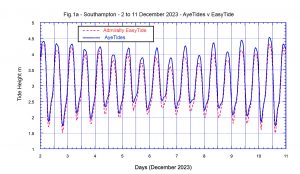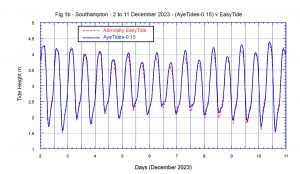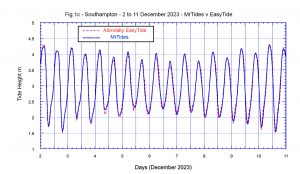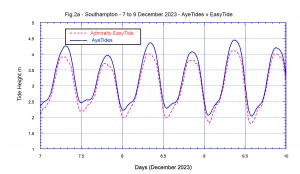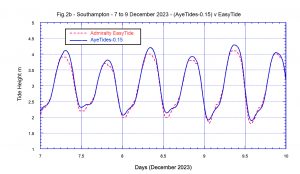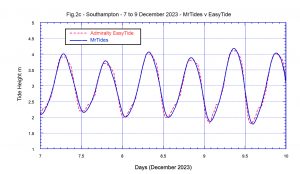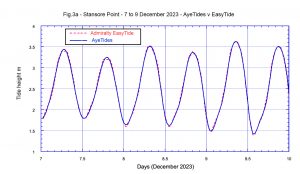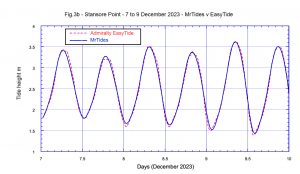6th Dec: Astronomical Tide Values (2)
Introduction: Following my discovery of a high bias in AyeTides values for Southampton, Hahn Software (creators of MrTides and AyeTides) suggested that the bias could be corrected by subtracting 0.15m from the AyeTides values, effectively shifting the datum for the tidal estimates. They said they had used 4 years of BODC data1 (presumably for Portsmouth for the local area) in calculating the tidal coefficients. Since, compared to Ordnance Datum Newlyn, the difference in Chart Datum between Southampton and Portsmouth is only 1cm, I was dubious that this was a satisfactory correction so did further tests.
Method: Hahn Software had suggested that interpolation during curve fitting might introduce errors. While I’m sure my curve fitting does not (see Figure 1 of my previous post), for these tests I used the discrete values obtained using the “export values” facility for MrTides and AyeTides, and the numerical values listed on the EasyTides website. The disadvantages of this approach are:
- MrTides and AyeTides do not export values at exact intervals and not exactly on the hour or half hour.
- EasyTide only lists values at 30 minute intervals to 0.1m resolution.
These factors will introduce noise into the comparisons and great care would be needed in calculating mean differences to ensure that these are not skewed by small timing differences in the tidal curves. For that reason I will only present graphs below; however they will be sufficient to demonstrate the problem. The nearest half hourly values from AyeTides and MrTides were used to compare with EasyTide values.
Results: Figure 1 shows a comparison to astronomical tides for Southampton for the period 2nd to 10th December inclusive (click on figures to enlarge).
Figure 1a shows the high bias in the Southampton values from the AyeTides application. Figure 1b shows that subtracting 0.15m from AyeTides works quite well at the start of the period but less well on the later days. Figure 1c shows that this error does not occur in the MrTides values.
For clarity, Figure 2 shows the same comparisons as Figure 1 but only for the period 7th to 9th December 2023 inclusive. For this period, subtracting 0.15m from the AyeTides values (Figure 2b) does not adequately match the EasyTide values. However the MrTides values are in reasonable agreement. I had previously found that AyeTides works slightly better than MrTides for Portsmouth, so this time varying bias for Southampton suggests a mistake in one or more of the tidal coefficients for that port.
As a further check I compared the tidal estimates for Stansore Point which is roughly equidistant from Portsmouth and Southampton. The results (Figure 3) suggest that, as at Portsmouth, AyeTides matches the Admiralty EasyTide values slightly better than MrTides. The bias in the AyeTides values for Southampton does not occur in the AyeTide values for Stansore Point.
Conclusion: For Portsmouth and Stansore Point the new AyeTides application matches the Admiralty EasyTide values well and slightly better than MrTides. Any differences from the Admiralty values are probably within the uncertainty of the latter. However for Southampton there appears to be a significant error in the tidal coefficients used by AyeTides which was not present for MrTide. Subtracting 0.15m from the AyeTides values is not an adequate correction for this error.
1 The British Ocean Data Centre is hosted by the National Oceanography Centre; I was a senior research scientist at NOC Southampton!

